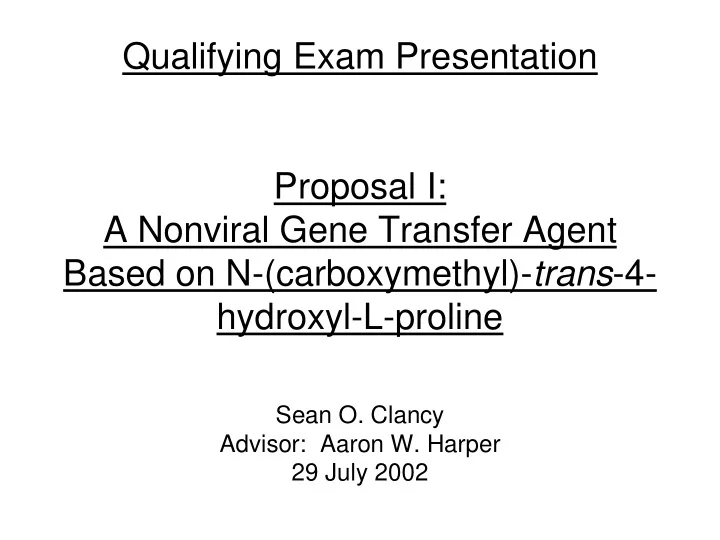

Qualifying Exam Presentation Proposal I: A Nonviral Gene Transfer Agent Based on N-(carboxymethyl)- trans -4- hydroxyl-L-proline Sean O. Clancy Advisor: Aaron W. Harper 29 July 2002
Overview I. Background A. Types of vectors 1. Viral: retroviruses, adenoviruses, etc. 2. Nonviral: liposomes, peptides, polymers, etc. B. Gene Delivery Process C. Gene Delivery Requirements II. N-(carboxymethyl)- trans -4-hydroxyl-L-proline based polymer A. Reasoning B. How it meets requirements III. Synthesis A. Monomer synthesis B. Polymer synthesis IV. Characterization and evaluation A. NMR B. Toxicity C. Transfection efficiency
Types of Vectors • Viral: retroviruses, adenoviruses, etc. – Must be de-evolved to be made safe. – Very expensive and sometimes dangerous. – Limits on size of DNA. • Nonviral: liposomes, peptides, polymers, etc. – Toxicity. – Lack of targeting. – Ease of engineering.
Gene Delivery Process • DNA protection outside and inside cells. • Bypass or escape from endocytotic pathways. • Efficient release of DNA . • DNA delivery to most of the target cells. • At best: – Efficient nuclear targeting. – High, persistent and adjustable therapeutic levels.
Gene Delivery Requirements • Be minimally toxic. • Efficiently transfect DNA. – Balance toxicity vs. transfection efficiency. • Biodegradable ester linkages. • Tertiary amine groups in interior. • Primary amine groups on exterior.
N-(carboxymethyl)- trans -4-hydroxy-L-proline • Reason for choice – 4-hydroxy-L-proline main component in collagen, which is nearly everywhere in the body of mammals. HO HO CO 2 H N CO 2 H N H CO 2 H N-(carboxymethyl)- trans -4-hydroxy-L-proline 4-hydroxy-L-proline • How it will meet requirements – Biodegradable ester linkages. – Internal tertiary amine to act as buffer.
Monomer Synthesis HO HO ClCH 2 CO 2 H BaCl 2 NaOH N N - Na + CO 2 H CO 2 H 1 2 - Na + CO 2 HO HO H 2 SO 4 + BaSO 4 N N - CO 2 CO 2 H Ba 2+ 4 3 - CO 2 CO 2 H HO HO SOCl 2 , MeOH N N CO 2 CH 3 CO 2 H 5 CO 2 CH 3 CO 2 H Chaouk, H.; Middleton, S.; Jackson, W. R.; Hearn, M. T. W.; International Journal of Bio- Chromatography ; 1997 , 2 (3), 153.
End Group Synthesis Troc HN (CH 2 ) 3 H 2 N (CH 2 ) 3 Cl 3 CCH 2 OCOCl N (CH 2 ) 4 HN (CH 2 ) 4 pyridine or aq. NaOH, Troc HN (CH 2 ) 3 HN (CH 2 ) 3 r.t. 9 8 NH Troc NH 2 K 2 CO 3 / DMF acetone, dry Br OH Troc 70 deg C Troc HN (CH 2 ) 3 HN (CH 2 ) 3 N (CH 2 ) 4 tosyl chloride, pyr., N (CH 2 ) 4 Troc N (CH 2 ) 3 0 deg C Troc N (CH 2 ) 3 NH Troc 11 10 NH Troc O HO Tos
Polymer Synthesis O O HO O + N O N CO 2 CH 3 CO 2 CH 3 6 5 O O bulk polymerization under reduced pressure, 140 deg C O O -MeOH N O N O O O O O O O O O O N O N N N O O O 7 O O O O
Polymer Synthesis H 2 N (CH 2 ) 3 (CH 2 ) 4 (CH 2 ) 3 HN HN N NH 2 (CH 2 ) 4 (H 2 C) 3 N (CH 2 ) 3 NH 2 NH 2 O O O O O O O O N O O N N O N O H 2 N O O O O Troc O (H 2 C) 3 N HN (CH 2 ) 3 O O O (H 2 C) 4 N (CH 2 ) 4 NH 2 O N NH Polymer 7 Troc cleavage Troc N (CH 2 ) 3 (H 2 C) 3 (H 2 C) 3 NH 2 NH 2 NH Troc NH O K 2 CO 3 , 18-C-6 Zinc, THF, H 2 O 11 (H 2 C) 3 acetone, dry pH = 5.5 - 7.2 (CH 2 ) 4 N reflux O O N Tos O O O NH 2 (H 2 C) 3 N (H 2 C) 4 NH (H 2 C) 3 NH 2
Characterization 1 H and 13 C NMR • – Determination of DB (degree of branching) by 13 C NMR with aid of model compounds. O O O O O O O O N N N N O O O O O O O O O O O O Terminal Dendritic Linear N Linear C – DB = (N d + N t )/(N d + N t + N lC + N lN ) * • SEC with polystyrene and PAMAM as standards * Hawker, C. J.; Lee, R.; Frechet, J. M. J.; J. Am. Chem. Soc., 1991 , 113 , 4583.
Evaluation • Toxicity – Measured using an MTT assay. – Pale yellow color of MTT (3-(4,5-cimethylthiazol-2-yl)- 2,5-diphenyltetrazolium bromide) turns to blue when cleaved by living cells. • Transfection efficiency – Measure decrease or increase in target protein levels. – Include reporter gene in transfected DNA, such as green fluorescent protein (GFP).
Acknowledgements • The Harper Group • Committee Members – Patrick J. Case – Robert Bau – Jeremy C. Collette – Aaron W. Harper – Michael Julian – G. K. Surya Prakash – Cory G. Miller – William P. Weber – Asanga B. Padmaperuma – William H. Steier
Recommend
More recommend